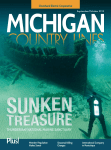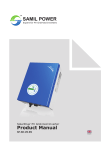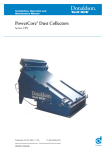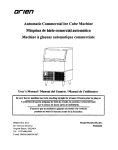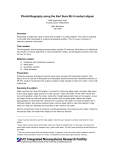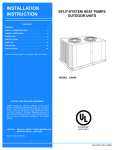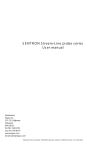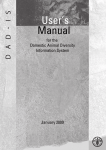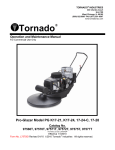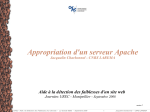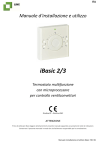Download About manuals
Transcript
About manuals Gunnar Björing Boksidan 1 About manual Gunnar Björing Index What are manuals and why do they exist? .................................................................................................................. 3 Various forms of manuals ...........................................................................................................................................6 Not even good instructions helps an user-unfriendly product ................................................................................... 11 General viewpoint concerning the design of manuals .............................................................................................. 18 Safety instructions..................................................................................................................................................... 19 Safety instructions..................................................................................................................................................... 19 Assembly instructions ............................................................................................................................................... 21 Operation instructions ............................................................................................................................................... 24 Maintenance/reparation/destruction instructions ...................................................................................................... 31 Translated from Swedish to Swedish English, by Google translator and Gunnar Björing. Copyright: Boksidan 2014 Box 558 146 33 Tullinge About manual, ISBN: 978-91-88109-05-7 Please feel free to copy this book, but then first pay the equivalent to 5 SEK to boksidan.com through Pay Pal. To administrate the payment go to www.boksidan.com and click on the “Add to chart” icon under the picture of this book. 2 What are manuals and why do they exist? Manual = installation + safety + operation + handling + reparation + destruction instructions. These various chapters that manuals usually consist of can also have other names such as installation instructions, maintenance manual or the like. In addition, each chapter is often divided into further subchapter. The first chapter, for example, could be divided into: assembly, installation and connection instructions. The size ratio between the different chapters varies depending on the nature of the object of the manual. For example, a construction detail may primarily be accompanied by installation instructions, while a computer program mostly requires user instructions and a disposable battery mostly need disposal instructions. There are various reasons why a particular product should, or must be, accompanied by instructions: 1. For users to use the products correctly, so that they, for instance, doesn’t break. 2. In order to better sell the product among potential customers. 3. For that there are regulations that require them to be accompanied by instructions. Notably with regard to products falling under the scope of the Machine directive1 and/or Low voltage directive2. 1. The Machine Directive (DIRECTIVE 2006/42/EC) applies to machines in which there is some kind of movement that is not driven by hand and their accessories, as well as various lifting equipment and safety components. But there are exceptions. The most common exceptions are: - Motor vehicles. - Household appliances intended for domestic use2. - AV equipment2. - Information technology equipment2. - Ordinary business machines2. - Switching equipment low voltage2. - Electrical motors2. 2. Such devices are instead mainly regulated by the low voltage directive. The Low Voltage Directive regulates the design from the electrical point of view of virtually all products to be used with a voltage between 50 to 1 000 V. However, with some exceptions, such as electrical parts for elevators and medical devices. The Machine Directive and The Low Voltage Directive enshrines the CE marking procedure will be implemented for the products. The purpose of the rules is that the products sell in Europe are as harmless as possible for users. For products that fall under the Machine Directive, the manufacturer shall ensure that they are safe by carefully analyzing them and, if possible, eliminate the hazards the analysis reveals. If it is not possible to eliminate the hazards, he shall warn for them on the products. 3 The products shall also be accompanied by instructions, whose design to some extent is defined by the Directive. See the excerpt from the directive below. With the most vital text for authors of manuals in green. "1.7.4.2 Contents of the instructions Each instruction manual must contain, where applicable, at least the following information: (a) the business name and full address of the manufacturer and of his authorised representative; (b) the designation of the machinery as marked on the machinery itself, except for the serial number (see section 1.7.3); (c) the EC declaration of conformity, or a document setting out the contents of the EC declaration of conformity, showing the particulars of the machinery, not necessarily including the serial number and the signature; (d) a general description of the machinery; (e) the drawings, diagrams, descriptions and explanations necessary for the use, maintenance and repair of the machinery and for checking its correct functioning; (f) a description of the workstation(s) likely to be occupied by operators; (g) a description of the intended use of the machinery; (h) warnings concerning ways in which the machinery must not be used that experience has shown might occur; (i) assembly, installation and connection instructions, including drawings, diagrams and the means of attachment and the designation of the chassis or installation on which the machinery is to be mounted; (j) instructions relating to installation and assembly for reducing noise or vibration; (k) instructions for the putting into service and use of the machinery and, if necessary, instructions for the training of operators; (l) information about the residual risks that remain despite the inherent safe design measures, safeguarding and complementary protective measures adopted; (m) instructions on the protective measures to be taken by the user, including, where appropriate, the personal protective equipment to be provided; (n) the essential characteristics of tools which may be fitted to the machinery; (o) the conditions in which the machinery meets the requirement of stability during use, transportation, assembly, dismantling when out of service, testing or foreseeable breakdowns; (p) instructions with a view to ensuring that transport, handling and storage operations can be made safely, giving the mass of the machinery and of its various parts where these are regularly to be transported separately; (q) the operating method to be followed in the event of accident or breakdown; if a blockage is likely to occur, the operating method to be followed so as to enable the equipment to be safely unblocked; 9.6.2006 L 157/48 Official Journal of the European Union EN (r) the description of the adjustment and maintenance operations that should be carried out by the user and the preventive maintenance measures that should be observed; (s) instructions designed to enable adjustment and maintenance to be carried out safely, including the protective measures that should be taken during these operations; (t) the specifications of the spare parts to be used, when these affect the health and safety of operators” In addition to the above points there is point "u" that is about data about the noise level. It conclusion that either the device does not produce noise, which the author indicates through writing that the noise level does not exceed 70 dB (A), on the distances from the machine where people normally are. Or he/she has to write down data from actual measurements of the noise levels at these distances. The last point "v" is about objects that emit ionizing radiation and it s therefore rarely relevant. To meet the requirements of many of the items such as: "e", "h" and "l -t", it requires the author, beyond necessary knowledge about the machine, also has a risk analysis as a basis for the writing. 4 For products that fall under the Low Voltage Directive, the manufacturer must ensure that they are safe from primarily an electrical perspective. By ensuring that the design is good and that the product is not misused and that it is managed properly. See the following excerpt from the Directive which has the, in this context, most relevant text is crossed out in green. "ANNEX I The most important safety requirements for electrical equipment designed for use within certain voltage limits First Terms and conditions a) To ensure that electrical equipment is used safely and in applications for which it is intended, should main data be marked on the equipment or, if this is not possible, on an accompanying notice. b) The brand name or trade mark should be clearly printed on the electrical equipment or, where that is not possible, on the packaging. c) The electrical equipment, together with its component parts shall be made in such a way that it is guaranteed that it can be assembled and connected in a safe and proper manner. d) The electrical equipment is designed and manufactured to protect against the hazards set out in paragraphs 2 and 3 of this Annex is assured providing that the equipment used for the purpose it is intended for and maintained in a satisfactory manner." 5 Various forms of manuals Manuals are mostly text-based. Though there are also manuals made in the form of drawings, symbols, instructional videos, and pop-up windows. Instructional videos have many advantages, but it probably requires that the object is complex and/or expensive otherwise the user’s wont waste time looking at them. Also pop-up windows have many benefits when they are applicable, which is the case if the object is a devices with a display. But neither instructional videos nor pop-up windows will be further affected in this text. Text or image-based instructions An advantage for text-based instructions is that they do not require any artist to make them. Moreover, it is easier for authors to edit the text afterwards compared to edit sketches. Some important advantages of animated instructions compared to text-based ditto is that it requires much less translation if the products are marketed in several countries and that in some cases it is easier to understand. One advantage with sketches compared to photos is that the latter often contains a lot of information that is not relevant in the context, which can confuse the viewer. Photos, on the other hand, are often more attractive than drawings in, for instance, cookbooks. 6 Example of an instruction which is probably easier to assimilate with pictures: Compared to if it was written with text only: Instructions for mounting handles No. 105 826 on a wardrobe door. Note If you do not understand these instructions, do not hesitate to call IKEA! 1. 2. 3. 4. 5. Obtain an awl. Obtain a screwdriver for srews with philips head. Take the handle and the two screws. Open the wardrobe door. Place the handle so that the screw holes are on the backside of the door and the rest of the handle is sticking out on the front. 6. Pull the handle up and down along the edge of the door until you find a height that seems to be appropriate. 7. Press the handle firmly against the door at the height you desire. 8. Make a small hole in the middle of one of the holes on the handle using the awl. 9. Hold the handle so that the hole is visible through corresponding the hole of the handle. 10. Insert one of the screws in the hole and tighten it. 11. Repeat 8-10 for the second hole of the handle. 7 An example of instructions that probably works better in text: The same instructions with pictures would require a number of pictures: 1.5 dl 1-2 min 1 dl Yet it would say less. 8 Symbol-based instructions The probably most common instructions are the washing instructions that are available on most clothes. These instructions are extremely brief and almost entirely based on symbols. Which to some extent are quite cryptic. But because they are so well established and standardized, we still understand how each item should be handled. The laundry pictograms describes which washing, and drying methods that are recommended. And if the garment can be chlorine bleached and / or ironed and what temperature the iron in that case should have. Water wash Chlorine bleaching Ironing Chemical wash The biggest advantage for garment manufacturers is that they can use the same label (instructions) in all its markets. Strangely, there are not many other areas where instruction symbols are the main way to convey information. Although many products are marketed in the same package in markets with many different languages, as in the European Union. Drying We could, for example, have standardized symbols for durability, cooking time and the parameters reported in the nutrition declaration on food packages. An reason that this is not the case may can be that it is difficult to design symbols that are easy to interpret. 9 Control unit for a bed with adjustable height and alignable head and foot side. A reasonable interpretation would be: Raise the head side ? ? ? ? A correct interpretation is: Lower the foot side Raise the head side Lower the head side Raise the bed Lower the bed Lower the foot side fotänden Raise the foot side A text would had, in this case, been easier to understand: 10 Head up Head down Bed up Bed down Foot up Foot down Not even good instructions helps an user-unfriendly product Aside from games, sports, and other things that are designed to contain elements that give them a moderately high degree of difficulty, most of what we encounter is made with the intention to be as easy to use as possible. Much of the annoying problems that may arise, when handling objects are probablydue to that they are unforgiving, illogical or un-consequent. And if so, not even the best of instructions will help. The object is unforgiving Many who have ever had exclusive wine glass with thin walls, probably know that they are extremely unforgiving for mal handling in the sink (often they are not dishwasher safe). In particular, as the one who cleans the glasses often have been involved in consuming the wine and thus may not be in the best shape. Instructions on how to clean the glasses would probably not help the users because none of them would even think of learning them by heart, or to read them before an upcoming dishwashing. But even if someone did that and also took the instructions into account, the risk would probably still be high that the cleaner made a careless, but normally harmless maneuver, which brakes one of the glasses. 11 The operation is illogical The features are more logical and easier to understand, the more they follow the basic principles that we are familiar with, such as: If a control lever is pushed upwards, it means an increase and down means the opposite. For horizontal levers, this is not as obvious. It may seem natural to push it ahead if you want to go forward and more forward the faster you want it to go. This is true for example, pull the boats and horses. In the latter case consists blip/control of their own bodies. Though it is the opposite for motorcycles. When the throttle is turned backwards the speed of the motorcycle increases. Because the throttles for motorcycles are an example of another well-established basic principle: A clockwise turn gives an increase and counterclockwise one gives the opposite. This relationship also applies of for instance screws (harder tightened) and the volume controls on music equipment. But it does not apply on water taps. A complication regarding this principle is that what is clockwise and counterclockwise depends on how you stand in relation to that which is rotated. As a rule, we lock right hanged door by turning the key counter clockwise, i.e. towards the door frame. But there are exceptions, such as the door lock above, which can be operated from both the inside and the outside. On the outside, the door is instead locked by turning the key in the direction of the arrows. Someone, perhaps to reduce confusion, has mounted an instruction there about how the lock is operated. Which unfortunatelly increases the confusion since it is open to two equally reasonable interpretations (Öppet= opend, Låst= locked): - If the lock is locked, turn it counterclockwise to make it unlocked, or - Do you want the lock to be locked, turn it counterclockwise. 12 A symbol on a knob that appears to symbolize an increase shall also result in an increase when the knob is operated that way. Temperature control on a shower faucet. Reasonable interpretation. Warmer Because the symbol gets more red, the higher up in the picture you look. Colder Colder Correct interpretation. Warmer This way the symbol had been less ambiguous. 13 Something that seems to be for a specific maneuver in the handling should not be for another maneuver Traffic signal control at crossing. This is a device containing a lamp an audio signal and an activation button. The idea is that it's a green light for vehicles as long as no one have pressed the button. If someone press it, the cars will have red light after a while and the pedestrians will have a green one, while this device emits a beep. On the top of the box there is a white circular field. It is the activation button. But it does not look like a button because it neither stand out or can be pushed in. The lamp that lights when someone phas ressed the button, however, sticks out, and it has an eye-catching design. Which at a first glance resembles a button. For people to understand what to do, the designer has added a symbol (a hand that is pointing). In addition, he added a symbol, that is hard to interpret, depicting a standing man. 14 The operation is in-consequent The more something all the time can be performed in the same way, the easier it is to master it. Those who have learned to ride a bike under certain circumstances don’t need take additional lessons to master the art under other circumstances. The pedal movements can be performed in the same way all the time, regardless of the circumstances for the moment. Cycling is thus a fairly consistent thing to do. Unlike, for example downhill skiing. The movements required are about as simple as them needed to ride a bike: Bend your knees, keep the entire weight on the downhill ski and switch point of gravity after each turn. How this should be done, however, varies considerably depending on the nature of the snow, the steepness of the slope and its flatness, making it much more difficult to master downhill skiing than cycling. It should always be the same events that happen as a result of the same grip regardless of what is happening at the moment. The object on the left is a pager. If someone calls it, the signals and the telephone number are displayed on the display. In addition to the phone number, the time when the search reached the pager is indicated. The pager’s functions are operated by a single button. To change various settings, such as selecting alarm tone or set the time, it is required that the user to presses the button in different sequences for different lengths of time. The sequences are so complicated that whoever lost the manual will have a lot of difficult to ever, for example, change to daylight saving time. 15 The less the user needs instructions the better This is partly because many probably never even open the manuals that come with some of the products they buy. Moreover probably even the most avid reader’s pretty soon forgets most of the instructions. Fortunately many objects are so simple that we can use them anyway. Take for example this ball pen. To be able to use it as intended, one need to get the ball out. Anyone reading this probably knows how to do, so for you a description about how to do it would probably be completely unnecessary. But even those who have never seen such a thing, would surely soon try pressing the button on the far left. Even if the person had no idea what he would use the ink-covered ball to, he or she would soon become aware of it. Another push on the button would clarify the whole function. However, there are many examples of objects that are so complicated that they require manuals. What's worse is that there are objects that should be simple, but the manufacturer has chosen to make them complicated, as the microwave oven below. To make the relatively common maneuver to change the heating time while the heating is in progress, the operator needs to know and do the following: 16 1. Press the Start/ Reset button. 2. Set a new timethrough a number of times press some of the buttons labeled "10 Min", "1 Min" or "10 Sec". 3. Press the Start/Reset button again. Compared to: 1. Turn the combined starting and timing knob clockwise or counterclockwise depending on whether you want to increase or decrease the heat treatment time. 17 General viewpoint concerning the design of manuals - Clarify the client's objectives with the manual and plan it accordingly (see the chapter about user instructions). - Distinguish between “shall” and “ought to” requirements. I.e. keep apart what must be done and what is good to do. Explain, if possible, why it is so, see the chapter: handling-/reparation-/destruction instructions. - Consistently use the same term for the same phenomenon and avoid using the same term for different things. - Do not soak the important information in unimportant details. To avoid this, the text is preferably divided into main instructions and footnotes. - Check if the text meets the requirements in applicable European Union directives. - Try, if possible, the text using some suitable persons, who may try to interpret and perform. 18 Safety instructions The Machinery Directive and Low Voltage Directive require that the instructions should warn of risks associated with the use. See the following excerpt from the Machinery Directive, with the most important, for a writer of instruction manuals, crossed out in green: "1.1.2 Principles of safety integration a) Machinery must be designed and constructed so that they can function as intended and operated, adjusted and maintained without putting persons at risk when these operations are carried out under the conditions foreseen but also taking into account any reasonably foreseeable misuse. The aim of the measures taken must be to eliminate any risk throughout the machine's life expectancy, which includes transportation, assembly, dismantling, to disabling and scrapping. b) In selecting the most appropriate methods, the manufacturer or his representative shall apply the following principles in the following order: - Risks to the extent possible eliminated or reduced (inherently safe design and construction). - Necessary precautions should be taken such risks can not be eliminated. - Information to be provided to the users of the residual risks due to any shortcomings of the protection measures adopted, indicate whether any particular training is required and the personal protective equipment needs to be provided. c) When designing and constructing machinery and when drafting the instructions, the manufacturer or his representative not only the intended use of the machinery but also any reasonably foreseeable misuse. The machine must be designed and constructed so as to prevent abnormal use if such use would engender a risk. Where appropriate, the user manual be made aware of such inappropriate use as experience has shown might occur. d) A machine shall be designed and constructed to take account of the constraints to which the operator is subject as a result of the necessary or foreseeable use of personal protective equipment. e) Machinery must be supplied with all the special equipment and all the accessories essential to enable the setup, maintenance and use in a safe manner." Note! Safety instructions shall be highlighted compared to the rest of the text. 19 Risks with safety instructions In the U.S., companies are very afraid that their products will harm someone. Because it can cause that they have to pay significant amounts of money to the harmed persons. A common way to avoid liability is to warn against all sorts of strange ways that customers could injure themselves. See for example this label who sat glued to the cord to a hair dryer. In Europe, fortunatelly, we don’t yet have have that system. Which means that we can avoid a lot of the very dafter warnings and instead only highlight relevant risks. Note that when a hair dryer falls into water it is likely that the electrical circuit short-circuit, before any fatal damage has been done. Machinery Directive and Low Voltage requirements are essentially good as long as they do not lead to an inflation of unnecessary safety regulations, which in turn leads to reduced respect for even the essential requirements. Or if, despite all the rules there are serious risks that the manufacturer has not warned for. 20 Assembly instructions Assembly instructions are preferably written as step by step instructions. Moreover, it is easy to write such instructions, because the author just needs to document what an experienced installer do from when he takes the item out of its packaging. All key elements of the step by step instructions should be described. Unfortunately, it is quite common that the instructions lack descriptions of key elements that are crucial for the success, which is the case in these instructions on how to mount a solar panel. The description is quite detailed on some points, such as, that about which of the clips that shall be mounted where on the battery. But several very important elements are missing (they are underlined in the comments on the next page): 21 1 2 3 4 5 6 1. What is the "south-north" direction do they mean facing south? 2. The important instructions about the panel’s angle versus the vertical are very cryptic. They would ideally be accompanied by a figure and since the instruction is directed specifically to us in Sweden, they could well have written what angle that is appropriate instead referring to something that is far from all aware. 3. All information is lacking about what to do if the about one meter long connecting cable is not sufficient for the distance between the panel and the battery. In particular, the important information that it must be a fuse on the cable near the battery. In other cases, the cable may start to burn in the event of a short circuit. Furthermore, it is not mentioned the battery terminals, in a permanent assembly, should be replaced by cable shoes for car batteries. Among other things, in order to make losses in the transmission as small as possible. 4. This information does not belong in this part of the instructions. 5. The panel on the picture seems to have a very strange position relative to the sun, the confusion would have been less if they had not depicted the sun in the picture. 6. It looks like the panel is to be mounted in the air, why didn’t they add a wall to the sketch. 22 Each step should contain as many or as complex operations. Since: 1. 2. 3. 4. The flow in the completion of the instruction will be better. The installer can easily check off each completed step. It reduces the risk that an operation is missed. It makes it easier to calculate how long time the whole work will take. It is advantageous to write explanations that are not required for the actual execution of the operations, in footnotes. The instructions for installing the solar panel could, in the light of the above, be designed as follows: Obtain: - A screwdriver with PZ2 head. - Any spacers, brackets etc. that is needed to attach the panel in the manner that is the most appropriate in your case. - Possibly a splicing cable (2-conductor cable for outdoor use with core diameters of at least 0.5 mm2). - Splicing devices, such as cable shoes. - Tools for splicing, such as a wire stripper or pliers. - Cable clamps with appropriate size. - A hammer for the cable clamps. - A fuse holder for a hang fuse. - Fuse, preferably 2-4 A. - Cable shoes for the + and – terminals on the battery. - A 12 V lead-acid battery. To do this: 1. Select a suitable3 spot. 2. Position the panel so that the black surface is facing the sun. 3. Fasten the panel with the four screws provided. 4. Secure the cable with cable clamps so that it ends at a suitable site for splicing. 5. Cut out the two battery terminals. 6. Splice the cable. Note It is important to note which wire is + and which is - in the new cable. 7. Secure the rest of the cable length required to reach the battery. 8. Assemble the fuse holder on the + wire. 9. Fit the + pole piece after the fuse holder. 10. Fit - pole piece on the negative wire. 11. Connect the pole pieces. 12. Insert the hanger fuse. 3. The location should be such that: - The active surface is directed to the south. - The panel is shaded as short part of the day as possible. - The panel, if possible, is inclined about 30-45° upwards against the sun. - The panel is reasonably protected from falling objects such as fruits, pine cones and branches. - The panel can be easily assembled and disassembled. - The cable from the panel to the battery can be mounted in a good way. 23 Operation instructions The design and scope of the operating instructions varies greatly depending on the object of the instructions, mainly due to: - The newer or more alien a technology is, the greater is the need for detailed instructions, see the example on the next page on how to make a phone call, and the sub-chapter about beginner instructions. - The reader’s purpose4 with the reading probably vary more than they do regarding other parts of the manuals. It may therefore be wise to investigate what is likely to be the most common purpose, and then customize the instructions accordingly. - The manufacturer purpose5 with the instructions also vary more than they do on other parts of the manuals. It may therefore be wise to investigate this too and act accordingly. 4. The purpose for some readers may, for example regarding instructions on advanced fishing paraphernalia, be to be entertained through reading about something that interest them, even if they have no real needed for the information. While regarding other things, like cell phones, they may have to read the manual just to be able to use the products. 5. The purpose for example, could be to raise the status of the product, reducing the number of questions from users or to meet the requirements in the Machinery Directive at the lowest possible cost. 24 All techniques have at some point in history been new and people have been unaccustomed to dealing with them. Below are the instructions from 1927 years telephone directory for Stockholm on how to make phone calls. 25 26 27 Beginner instruction is often preferably designed as step by step instructions. Many who read the instructions just wart’s to know how to get started, without first being forced to read and interpret long passages of unimportant text. But often it is very sparse with beginner instructions. This is especially true for more complex devices, such as this printer/scanner. In the nearly 90-page long manuals, as far as I have seen, there are only the following instructions on how to scan a document. Moreover the instructions are difficult to find since they are not found in the "Getting started" section. 28 In other manuals, however, it is relatively easy to find operating instruction that are based on step execution, though usually even those jumps over a multitude of steps that probably are assumed to be obvious. As the operating instructions for the marking unit below, where the majority of the use is described in the sentence: "Enter a text to write a simple label." The instructions of the above device are also an excellent example of the dangers of creating an original manual in a language then just translate it into other languages. In this case, it has the effect that it is not described anywhere how to obtain the in Swedish partially unique and frequently used letters "Å, Ä and Ö." 29 Essential instructions should, if possible, be written on the products. Since some users probably will forget the instructions and therefore handle the products incorrectly. To avoid this, essential and non abandoned handgrip should be described directly on the objects. Below is an example of a product where this is the case (the control devices to a mobile crane) and where it is not (the charger to an electric toothbrush). Control panel to a smaller mobile crane. If the operator misunderstand the instructions it may lead to serious mishaps .... How charging an electric toothbrush This text can be read in the manual, among a host of less important instructions. Even if the user reads the text and also adds the charging time and other facts about the charging in his memory, it is likely that he forgets them long before the toothbrush is worn out. Which, among other things, may result in the risk that he charges the toothbrush for too short time and thus never gets a full using. This risk had easily been reduced if the manufacturer had added information about the charging time on the charger. 30 Maintenance/reparation/destruction instructions The design of the maintenance instructions depends on the products. An expensive product, like a car, should be accompanied with far more care instructions than a toy. This for several reasons including that the importance of that the former is maintained in good condition is of major economic importance for the customers. Many other common products accompanied by a manual require, unlike cars, very little care. Thus the maintenance/reparation/destruction instructions can often be summarized in a few points that briefly deals with cleaning and disposal. There is however a few things you should keep in mind during the writing of these: Exaggerated demands may have the opposite effect. Often maintenance/reparation/destruction instructions implement pretty big demands on the users. If they they perceive demands as excessive there is a risk is that the users choose to ignore even reasonable requirements. See for example the following quotes from the manuals for a common electric toothbrush. Where it is describes what the user should do with worn out samples: The text says that the raw materials in this device ought to be recycled and therefore it shall be given to one of the manufacturers service work shops. 31 Requirements without description of the risks when not obeying, is annoying. It is quite common that there are requirements in the maintenace instructions that are not accomplished with an explanation about why. Which makes it hard for the users to choose an, in their opinion, reasonable level of care. The instructions for the toothbrush are also home for such examples, for instance: The text says that after each use the whole toothbrusch shall be rinsed with the motor on. Then the brusch head shall be removed from the machine and then both parts shall be rinsed and wiped. If these instructions are followed some of the idea of using an electric toothbrush is deflected, because the work avoided and time saved from using the electric brush is partially lost in the process of the cleaning the device. On the other hand, if one chooses to resist cleaning, one may get the sense of being a filth pig. Alternatively, this can be a source of argument between "pedant" and "filth pig" if there is more than one user of the same object. Here it would have been reasonable to explain what the consequence would be for those who do not follow the daily cleaning instruction. Would the effect be a nasty bacterial growth, which in turn can transmit diseases or would the effect is only be that the device looks untidy? 32
































